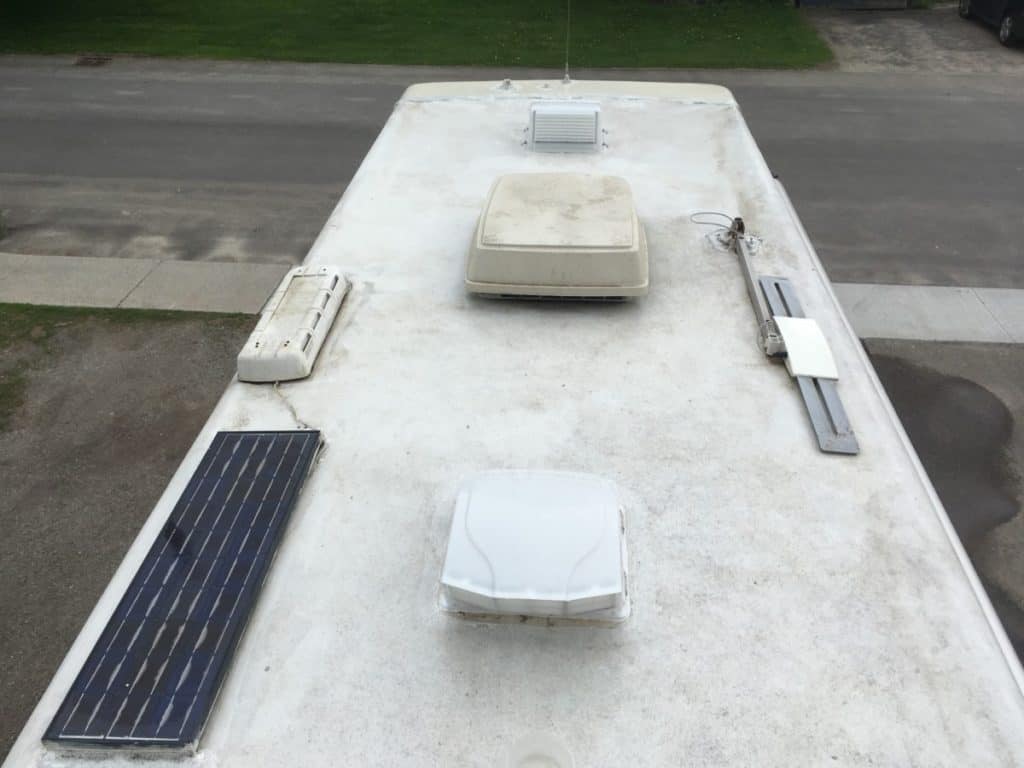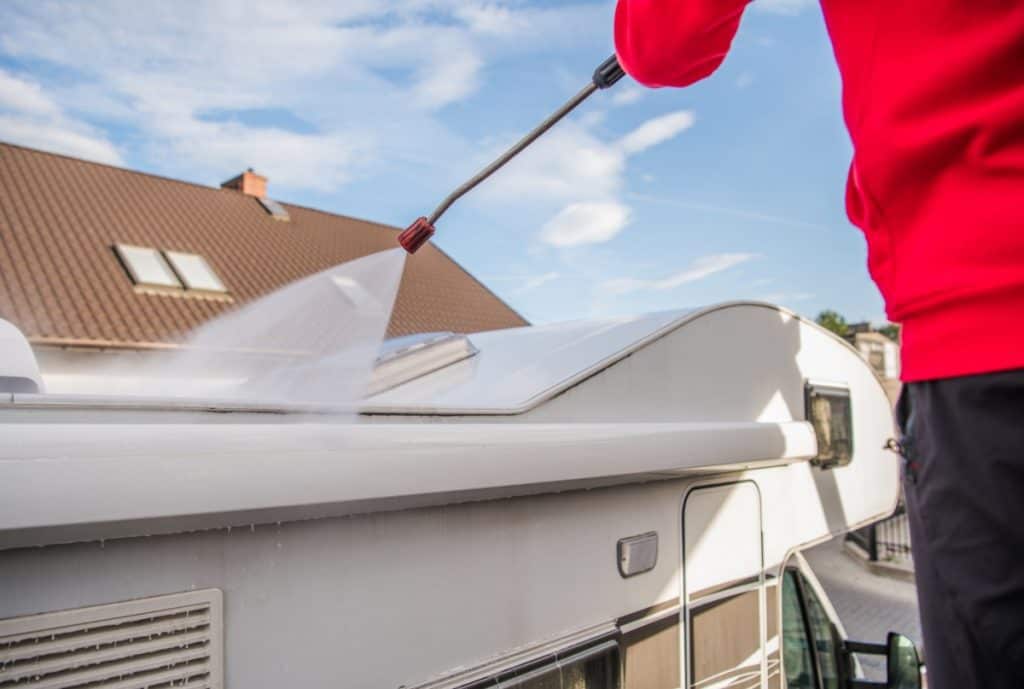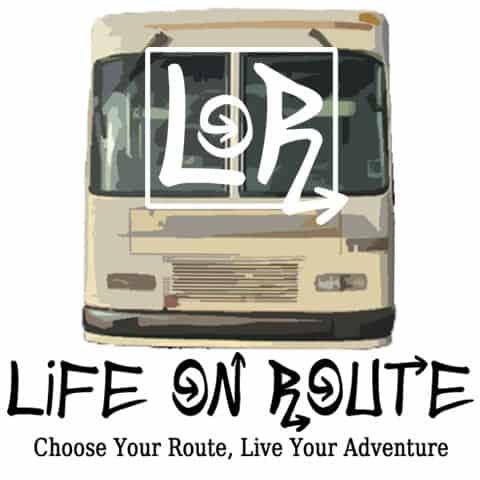This post contains affiliate links.
It’s that time again – time to climb up that ladder and clean your RV’s rubber roof. While the task may seem daunting, it’s actually easier than you might think.
To clean your RV’s roof, use a cleaner that isn’t petroleum or citric-acid based, scrub one section at a time, look for any damaged areas, and check the user manual to make sure you don’t need to do anything extra special for maintenance.
You probably have a bunch of questions like how often to clean your roof and what to use to clean rubber roofs on RVs. In this guide you’ll find the answers to those questions and others so that there’s no guesswork in getting your roof cleaned up right.

Table of Contents
How to Wash a rubber RV roof
However you scrub the roof, always make sure you look before you take a step, try to avoid stepping backwards, and make sure your shoes have a good grip. If you fall you could get very badly injured, or worse. I think we can all agree that camping is a lot more fun without hospital visits.
Inspect Windows, Doors and Seals
Before you start in on your roof you’ll want to do an inspection for any damages. Look for bumps, ripples, cracks, or soft spots in the roofing material, and check the seals around all of your vents and edges to make sure they’re still water tight. One way you can tell it’s gone bad is if you see streaks of dirt going under the seal.
Rinse The RV
The first step is to spray down the sides, front, and back of your RV. The cleaner running off your roof as you go can leave dirt trails on the sides of your RV and can even damage the graphics in some cases. A pre-rinse will help, but you’ll still want to spray the sides periodically and after you’re done.
Spraying and Scrubbing
Once you’ve ensured everything is as it should be, spray down your roof. This will knock off any loose dirt, dust, pollen, bugs etc. Then, apply your cleaner to a small section of the roof and use a soft- to medium-bristle scrub brush on it. Doing three foot by three foot sections works well, and you can work from front to back, back to front, or whichever way you feel the most comfortable.
You’ll want to scrub in circular motions as you go, making sure you cover the whole section. Once you’re done with that area, spray off the cleaner and inspect your handiwork. If your roof is especially dirty you may need to give it another round of scrubbing, or you may be good to move on.
- NO-SCRATCH SOFT BRISTLES WITH PROTECTIVE RUBBER BUMPER – Bristles are soft so they do not scratch when scrubbing. Rubber bumper around...
- SAVE TIME, SKIP THE LADDER – REACH UP TO 25+ FEET WHEN STANDING – Included is an Eversprout Extension Pole (6.5 to 18 ft) and Scrub...
- THE EVERSPROUT ADVANTAGE – 1 YEAR WARRANTY, MIND-BLOWING USA CUSTOMER SERVICE, 1 TREE PLANTED WITH EVERY ORDER – When’s the last time...
Rinse Detergent and Repeat
As you progress from section to section make sure you are getting plenty of overlap between them. Repeat scrubbings as often as necessary, and make sure you rinse off the cleaner after each section. Don’t forget to spray a little extra water over the edges to help remove any cleaner going down the sides.
After you have finished cleaning the last area, do a final inspection to make sure you haven’t missed any stains, sap, mildew, mold, or any other substance that needs to be cleaned.
Cleaners To Avoid Using on a Rubber RV Roof
There are many more products that you can use to clean your RV’s roof than you can’t, but you’ll definitely want to avoid any petroleum-based or citric acid-based chemicals, as well as anything with mineral spirits.
These distillates can spell disaster for your rubber roof because of a chemical reaction that causes the rubber to swell and detach from the structural substrate below. This makes the rubber more prone to damage, not to mention these chemicals also discolor your roof.
What Type of Cleaner Can You Use on a Rubber RV Roof
So now that you know what to avoid, you’re probably wondering what to use to clean RV rubber roofs that’s safe. You can use dish soap like Dawn or a non-abrasive cleaner like Spic N Span, or you can go for one of the store-bought roof cleaning products.
Dawn seems to have pretty good reviews for effectiveness; Spic N Span and other cleaners are a little more hit and miss in the forums. If you want to make sure you get the job done right the first time and what you’re using is completely safe, your best bet is to go with the a high quality RV roof cleaning product.
For especially tough stains you can use diluted hydrogen peroxide or even bleach, but you’ll want to make sure they are well-diluted and only use them sparingly to prevent any damage from occurring.
- USE: Helps care for your RV roof by cleaning off dirt and grime
- RV MAINTENANCE: Make sure your RV is ready for applications of coating and more
- EASY TO USE: Simply spray on, brush with a medium bristle brush and rinse off
Can I Pressure Wash My RV Roof?
Scrubbing can be a pain, and if you’re short on time and elbow grease you may be looking for an easier alternative. You can use a pressure washer on your RV’s roof instead of a scrub brush, but there are several things you should know first.
To start, you don’t want the pressure to be too high or you can risk doing damage. Some pressure washers can reach 3,000 PSI – great for your concrete driveway, but not for your rubber roof. Try to cap the pressure at 1,300 PSI.
You can also damage the seals around the roof vents and joints with a pressure washer if you’re not careful, and they even have the potential to force water around the seal and into your RV. Instead of pressure washing your whole roof, it may be safer to just blast the stubborn spots.
To summarize, the short answer to can you pressure wash a RV rubber roof is yes, but you should proceed with caution.

How to Remove Mold from Your RV Roof
The good news is that your roof is naturally resistant to mold and mildew, but the bad news is that it can find a way to grow anyways – especially if you live in humid areas. To clean off mold you’re going to need more than Dawn or roof cleaner; you’ll have to reach for bleach or Tilex.
You won’t want to spray a large area at a time with Tilex or a bleach solution, but you will want to leave it on the surface for at least five minutes to let it work. Scrub the mold and mold stains out after and rinse the area off.
Keep in mind that Tilex especially is bad for paint, so if any spills over the side of your RV you’re going to want to clean it up as quickly as possible with a damp rag or sponge.
How to Remove Tree Sap from Your RV Roof
The first thing you can try to get that pesky sap off is to put some ice on it and see if that will let you remove it. As the sap cools and hardens it can lose it’s sticky bond with the rubber, allowing you to peel it off.
If that doesn’t work, you can try plan B for how to remove tree sap from RV roofs: mineral spirits. But didn’t I tell you never to use that? Yes. And you should NEVER put it directly on your roof even to combat sap.
Instead, pour a tiny amount on a cloth or rag, as little as you can get away with using, and then scrub just at the spot covered in sap. Once you’ve gotten the sap off you should rinse the area to remove any remaining mineral spirits since they are petroleum-based and can cause significant damage.
How Often to Clean Your RV Roof
If your RV lives in a field or driveway away from trees, you should only have to clean the roof every six months or so. Having said that, it wouldn’t hurt to pop up the ladder and inspect it more frequently and six months is the longest I would go between cleanings.
If you’re under trees a lot, it’s pollen season, or you live where it’s often humid, you’ll probably want to clean the roof every three months instead. Trees drop leaves, bugs, sap, and hold birds that drop poop. Pollen will turn everything yellow, and constant humidity is a recipe for mildew and mold. As long as you use a safe cleaner, you won’t hurt your roof by cleaning it more often.
Types of Rubber RV Roofs
Rubber RV roofs are either going to be made of ethylene propylene diene monomer (EPDM) or thermoplastic olefin (TPO). EPDM roofs are more durable than TPO roofs and require less maintenance over their lifetimes.
You may have to repair minor issues with TPO roofs more frequently, and TPO also needs to be resealed periodically. EPDM on the other hand does not require any kind of sealant or treatment, though you can often find manufacturer recommendations on how to clean and treat RV rubber roofs in your user manual.
Closing Thoughts
While you’re cleaning your RV roof it may be a good time to have a look at the awning condition and make sure it’s ready for a full season. Check out our post on How to Clean and Remove Mold from an RV Awning
You now know how to wash RV roofs and how often – use a non-abrasive and non-petroleum or citric acid-based cleaner every 3-6 months as needed, and check your roof’s specific material to see whether you need to apply a sealant or other treatment.


